Impact of Cross-Flow and Membrane Plate Filtrations under Winery-Scale Conditions on Phenolic Composition, Chromatic Characteristics and Sensory Profile of Different Red Wines
Abstract
:1. Introduction
2. Materials and Methods
2.1. Red Wines
2.2. Winery-Scale Filtration Conditions
2.3. General Wine Physicochemical Characterization
2.4. Global Phenolic Parameters
2.5. Turbidity and Chromatic Characteristics
2.6. Fractionation of Proanthocyanidins According to Their Degree of Polymerization
2.7. Individual Monomeric Anthocyanins Analysis
2.8. Sensory Evaluation
2.9. Statistical Analysis
3. Results and Discussion
3.1. General Physicochemical Composition
3.2. Turbidity Measurement
3.3. Changes on General Phenolic Composition and Color Parameters
3.4. Changes in Monomeric Anthocyanins
3.5. Changes in Tanning Power and Fractions of Proanthocyanidins
3.6. Sensory Evaluation
3.7. Principal Components Analysis Applied to Wine Phenolic and Sensory Characterization
4. Conclusions
Author Contributions
Funding
Data Availability Statement
Acknowledgments
Conflicts of Interest
References
- El Rayess, Y.; Mietton-Peuchot, M. Membrane technologies in wine industry: An Overview. Crit. Rev. Food Sci. Nutr. 2016, 56, 2005–2020. [Google Scholar] [CrossRef] [PubMed]
- Vernhet, A. Red wine clarification and stabilization. In Red Wine Technology, 1st ed.; Morata, A., Ed.; Elsevier Academic Press: London, UK, 2019; pp. 237–251. [Google Scholar]
- El Rayess, Y.; Manon, Y.; Jitariouk, N.; Albasi, C.; Mietton-Peuchot, M.; Devatine, A.; Fillaudeau, L. Wine clarification with rotating and vibrating Filtration (RVF): Investigation of the impact of membrane material, wine composition and operating conditions. J. Membr. Sci. 2016, 513, 227–244. [Google Scholar] [CrossRef] [Green Version]
- Czekaj, P.; Lopez, F.; Guell, C. Membrane fouling during microfiltration of fermented beverages. J. Membr. Sci. 2000, 166, 199–212. [Google Scholar] [CrossRef]
- Vernhet, A.; Cartalade, D.; Moutounet, M. Contribution to the understanding of fouling build-up during microfiltration of wines. J. Membr. Sci. 2003, 211, 357–370. [Google Scholar] [CrossRef]
- Ulbricht, M.; Ansorge, W.; Danielzik, I.; Koenig, M.; Schuster, O. Fouling in microfiltration of wine: The influence of the membrane polymer on adsorption of polyphenols and polysaccharides. Sep. Purif. Technol. 2009, 68, 335–342. [Google Scholar] [CrossRef]
- Buffon, P.; Heyman, H.; Block, D. Sensory and chemical effects of cross-flow filtration on white and red wines. Am. J. Enol. Vitic. 2014, 65, 305–314. [Google Scholar] [CrossRef]
- Peri, C.; Riva, M.; Decio, P. Cross-flow membrane filtration of wines—Comparison of performance of ultrafiltration, microfiltration, and intermediate cutoffs membranes. Am. J. Enol. Vitic. 1988, 39, 162–168. [Google Scholar]
- Sims, C.A.; Bates, R.P.; Johnson, R.P. Comparison of pre-fermentation and post-fermentation ultrafiltration on the characteristics of sulfited and nonsulfited white wines. Am. J. Enol. Vitic. 1990, 41, 182–185. [Google Scholar]
- Oberholster, A.; Carstens, L.M.; du Toit, W.J. Investigation of the effect of gelatine, egg albumin and cross-flow microfiltration on the phenolic composition of Pinotage wine. Food Chem. 2013, 138, 1275–1281. [Google Scholar] [CrossRef]
- Arriagada-Carrazana, J.P.; Saez-Navarrete, C.; Brodeu, E. Membrane filtration effects on aromatic and phenolic quality of Cabernet Sauvignon wines. J. Food Eng. 2005, 68, 363–368. [Google Scholar] [CrossRef]
- Martínez-Lapuente, L.; Guadalupe, Z.; Ayestarán, B. Effect of egg albumin fining, progressive clarification and cross-flow microfiltration on the polysaccharide and proanthocyanidin composition of red varietal wines. Food Res. Int. 2017, 96, 235–243. [Google Scholar] [CrossRef] [PubMed]
- Palacios, V.M.; Caro, I.; Pérez, L. Comparative study of crossflow microfiltration with conventional filtration of sherry wines. J. Food Eng. 2002, 54, 95–102. [Google Scholar] [CrossRef]
- McRae, J.M.; Mierczynska-Vasilev, A.; Soden, A.; Barker, A.M.; Day, M.P.; Smith, P.A. Effect of commercial-scale filtration on sensory and colloidal properties of red wines over 18 months bottle aging. Am. J. Enol. Vitic. 2017, 68, 263–274. [Google Scholar] [CrossRef]
- Ribéreau-Gayon, P.; Glories, Y.; Maujean, A.; Dubourdieu, D. Handbook of Enology: The Chemistry of Wine Stabilisation and Treatments, 2nd ed.; John Wiley & Sons Ltd.: Chichester, UK, 2006; p. 497. [Google Scholar]
- Kramling, T.E.; Singleton, V.L. An estimate of the non-flavonoid phenols in wines. Am. J. Enol. Vitic. 1969, 20, 86–92. [Google Scholar]
- Somers, T.C.; Evans, M.E. Spectral evaluation of young red wines: Anthocyanin equilibria, total phenolics, free and molecular SO2, chemical age. J. Sci. Food Agric. 1977, 28, 279–287. [Google Scholar] [CrossRef]
- Ribéreau Gayon, P.; Stonestreet, E. Le dosage des tannins du vin rouge et la détermination de leur structure. Chim. Anal. 1966, 48, 188–196. [Google Scholar]
- De Freitas, V.; Mateus, N. Structural features of procyanidin interactions with salivary proteins. J. Agric. Food Chem. 2001, 49, 940–945. [Google Scholar] [CrossRef] [PubMed]
- O.I.V. International Oenological Codex; O.I.V.: Paris, France, 2014. [Google Scholar]
- Sun, B.S.; Leandro, C.; Ricardo-da-Silva, J.M.; Spranger, I. Separation of grape and wine proanthocyanidins according to their degree of polymerization. J. Agric. Food Chem. 1998, 46, 1390–1396. [Google Scholar] [CrossRef]
- Sun, B.S.; Ricardo-da-Silva, J.M.; Spranger, I. Critical factors of vanillin assay for catechins and proanthocyanidins. J. Agric. Food Chem. 1998, 46, 4267–4274. [Google Scholar] [CrossRef]
- Dallas, C.; Laureano, O. Effects of pH, sulphur dioxide, alcohol content, temperature and storage time on colour composition of a young portuguese red table wine. J. Sci. Food Agric. 1994, 65, 477–485. [Google Scholar] [CrossRef]
- Parr, W.V.; Heatherbell, D.; White, K.G. Demystifying wine expertise: Olfactory threshold, perceptual skill, and semantic memory in expert and novice wine judges. Chem. Senses 2002, 27, 747–755. [Google Scholar] [CrossRef]
- Prodanov, M.P.; Aznar, M.; Cabellos, J.M.; Vacas, V.; López, F.; Hernández, M.T.; Estrella, M.I. Tangential-flow membrane clarification of Malvar (Vitis vinifera L.) wine: Incidence on chemical composition and sensorial expression. OENO One 2019, 53, 725–739. [Google Scholar] [CrossRef]
- Serrano, M.; Pontens, B.; Ribéreau-Gayon, P. Etude de différentes membranes de microfiltration tangentielle. Comparaison avec la filtration sur précouche de diatomées. OENO One 1992, 26, 97–116. [Google Scholar] [CrossRef]
- Vernhet, A.; Pellerin, M.P.; Belleville, J.; Planqueand, J.; Moutounet, M. Relative impact of major wine polysaccharides on the preformances of an organic microfiltration membrane. Am. J. Enol. Vitic. 1999, 50, 51–56. [Google Scholar]
- El Rayes, Y.; Albasi, C.; Bacchin, P.; Taillandier, P.; Raynal, J.; Mietton-Peuchot, M.; Devatine, A. Cross-flow microfiltration applied to oenology: A review. J. Membr. Sci. 2011, 382, 1–19. [Google Scholar] [CrossRef] [Green Version]
- Czekaj, P.; Lopez, F.; Guell, C. Membrane fouling by turbidity constituents of beer and wine: Characterization and prevention by means of infrasonic pulsing. J. Food Eng. 2001, 49, 25–36. [Google Scholar] [CrossRef]
- El Rayess, Y.; Albasi, C.; Bacchin, P.; Taillandier, P.; Mietton-Peuchot, M.; Devatine, A. Analysis of membrane fouling during cross-flow microfiltration of wine. Innov. Food Sci. Emerg. Technol. 2012, 16, 398–408. [Google Scholar] [CrossRef] [Green Version]
- Cameria-dos-Santos, P.J.; Cheynier, V.; Brillouet, J.-M.; Cadot, Y.; Escudier, J.L.; Roesink, H.D.V.; Moutonet, M. Cross-flow filtration of wines with polymeric: The influence of winemaking technology and back pulse on the fouling process. Prehrambeno Technol. Biotehnol. Rev. 1994, 32, 77–83. [Google Scholar]
- Monagas, M.; Bartolomé, B.; Gomez-Cordovés, C. Evolution of polyphenols in red wines from Vitis vinifera L. during aging in the bottle. Eur. Food Res. Technol. 2005, 220, 331–340. [Google Scholar] [CrossRef]
- Oliveira, J.; De Freitas, V.; Mateus, N. Polymeric pigments in red wines. In Book Red Wine Technology; Morata, A., Ed.; Elsevier Academic Press: London, UK, 2019; pp. 207–218. [Google Scholar]
- Cameria-dos-Santos, P.J.; Brillouet, J.-M.; Cheynier, V.; Moutounet, M. Detection and partial characterization of new anthocyanin-derived pigments in wine. J. Sci. Food Agric. 1996, 70, 204–208. [Google Scholar] [CrossRef]
- Salazar, F.N.; de Bruijn, J.P.F.; Seminarion, L.; Güell, C.; López, F. Improvement of wine crossflow microfiltration by a new hybrid process. J. Food Eng. 2007, 79, 1329–1336. [Google Scholar] [CrossRef]
- Martínez, J.A.; Melgosa, M.; Pérez, M.M.; Hita, E.; Negueruela, A.I. Visual and instrumental color evaluation in red wines. Food Sci. Technol. Int. 2001, 7, 439–444. [Google Scholar] [CrossRef]
- Gonçalves, F.; Rocha, S.M.; Coimbra, M.A. Study of the retention capacity of anthocyanins by wine polymeric material. Food Chem. 2012, 134, 957–963. [Google Scholar] [CrossRef] [PubMed]
- Vieira, G.S.; Moreira, F.K.V.; Matsumoto, R.L.S.; Michelon, M.; Filho, F.M.; Hibinger, M.D. Influence of nanofiltration membrane features on enrichment of Jussara ethanolic extract (Euterpe edulis) in anthocyanins. J. Food Eng. 2018, 226, 31–41. [Google Scholar] [CrossRef]
- González-Muñoz, B.; Garrido-Vargar, F.; Pavez, C.; Osorio, F.; Cheny, J.; Bordeu, E.; O’Brien, J.A.; Brossard, N. Wine astringency: More than just tannin-protein interactions. J. Sci. Food Agric. 2021; in press. [Google Scholar] [CrossRef] [PubMed]
- Oberholster, A.; Francis, I.; Lland, P.; Waters, E. Mouthfeel of wines made with and without pomace contact and added antohcyanins. Aust. J. Grape Wine Res. 2009, 15, 59–69. [Google Scholar] [CrossRef]
- Vernhet, A.; Moutounet, M. Fouling of organic microfiltration membranes by wine constituents: Importance, relative impact of wine polysaccharides and polyphenols and incidence of membrane properties. J. Membr. Sci. 2002, 201, 103–122. [Google Scholar] [CrossRef]
- Maury, C.; Sarni-Manchado, P.; Lefebvre, S.; Cheynier, V.; Moutounet, M. Influence of fining with different molecular weight gelatins on proanthocyanindin compostion and perception of wines. Am. J. Enol. Vitic. 2001, 52, 140–145. [Google Scholar]
- González-Neves, G.; Favre, G.; Gil, G. Effect of fining on the colour pigment composition of young red wines. Food Chem. 2014, 157, 385–392. [Google Scholar] [CrossRef]
- Maury, C.; Sarni-Manchado, P.; Lefebvre, S.; Cheynier, V.; Moutounet, M. Influence of fining with plant proteins proanthocyanidin compostion of red wines. Am. J. Enol. Vitic. 2003, 54, 105–111. [Google Scholar]
- Mateus, N.; Silva, A.M.S.; Vercauteren, J.; De Freitas, V. Occurrence of anthocyanin-derived pigments in red wine. J. Agric. Food Chem. 2011, 49, 4836–4840. [Google Scholar] [CrossRef] [PubMed]
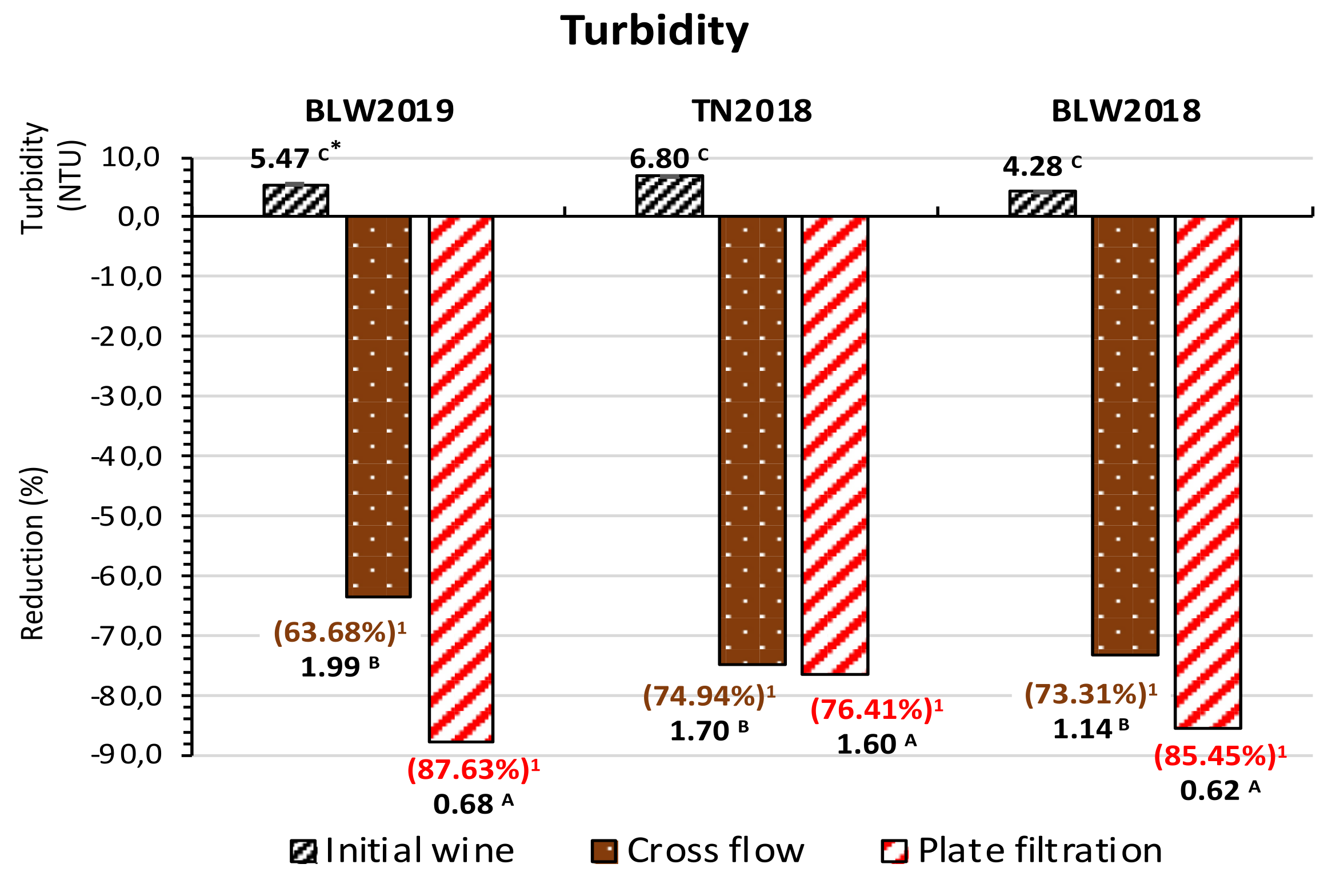
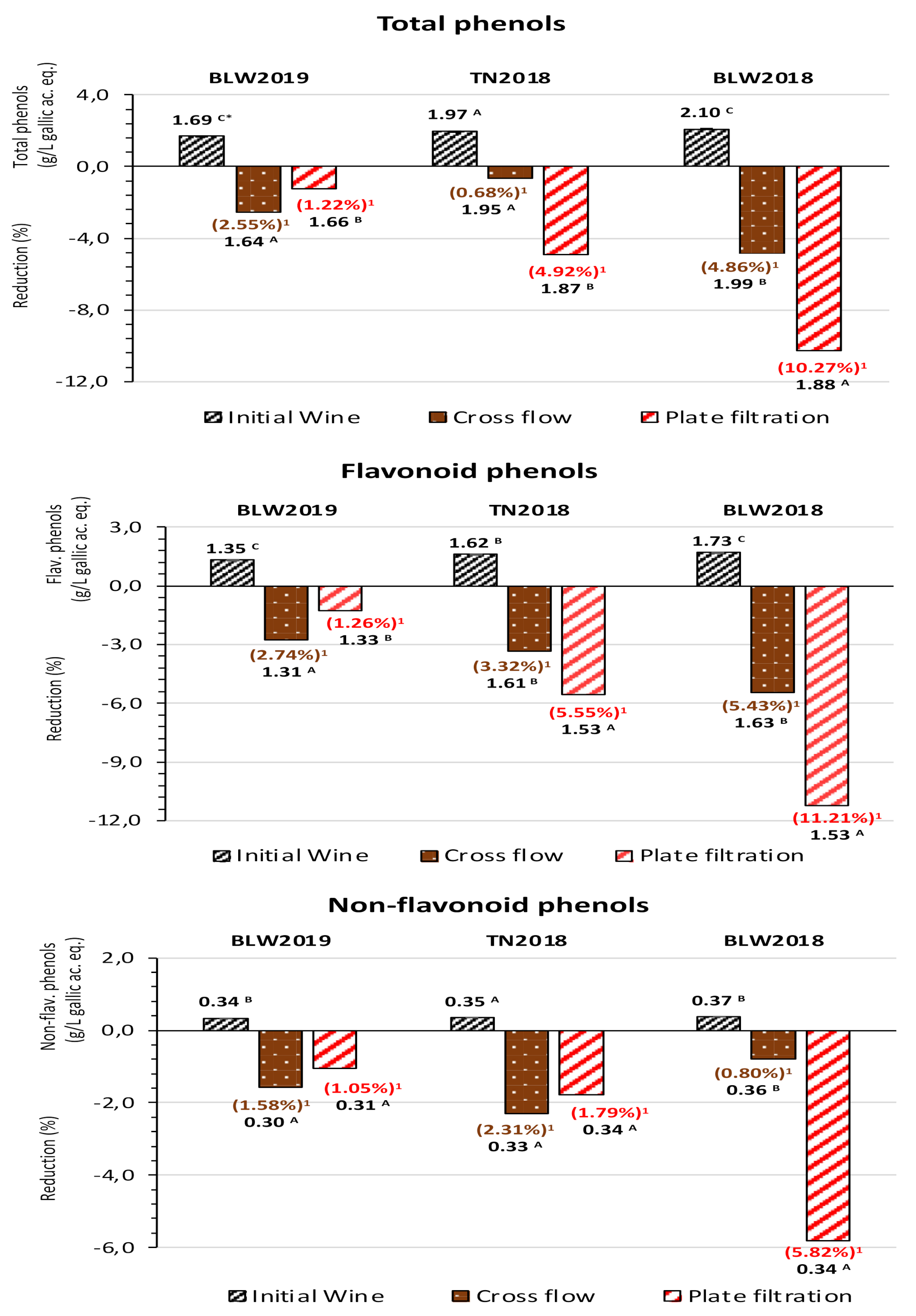
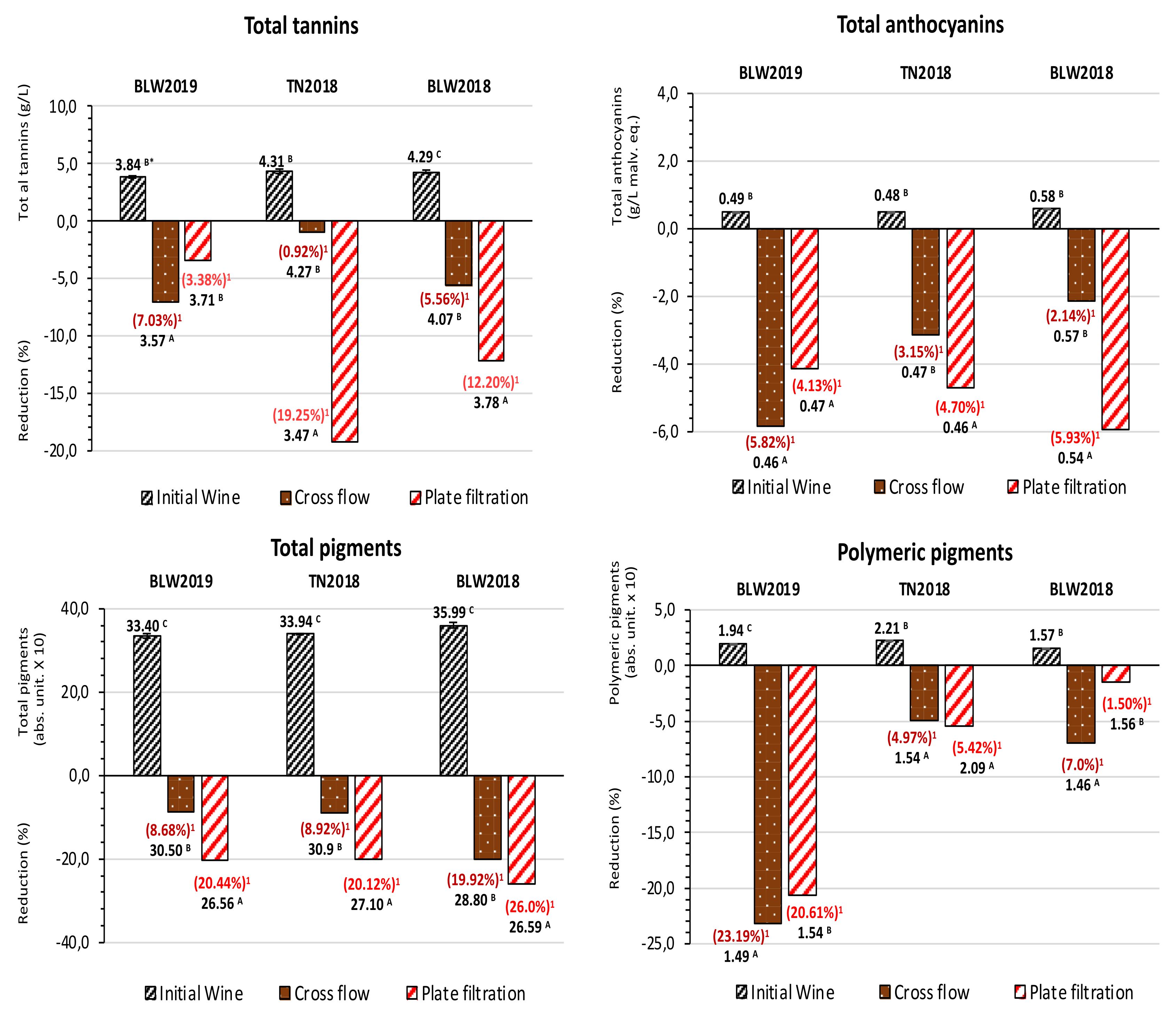
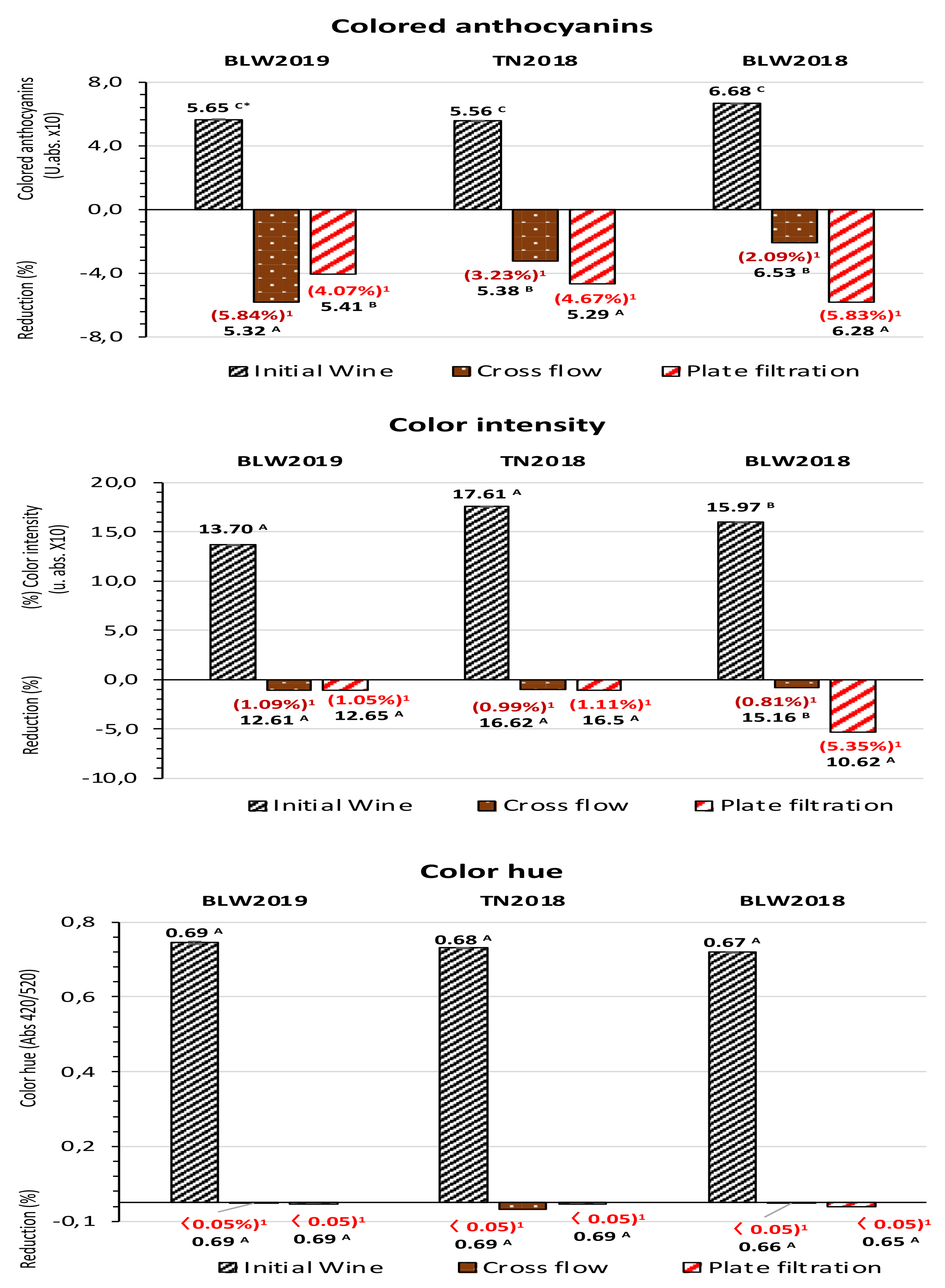
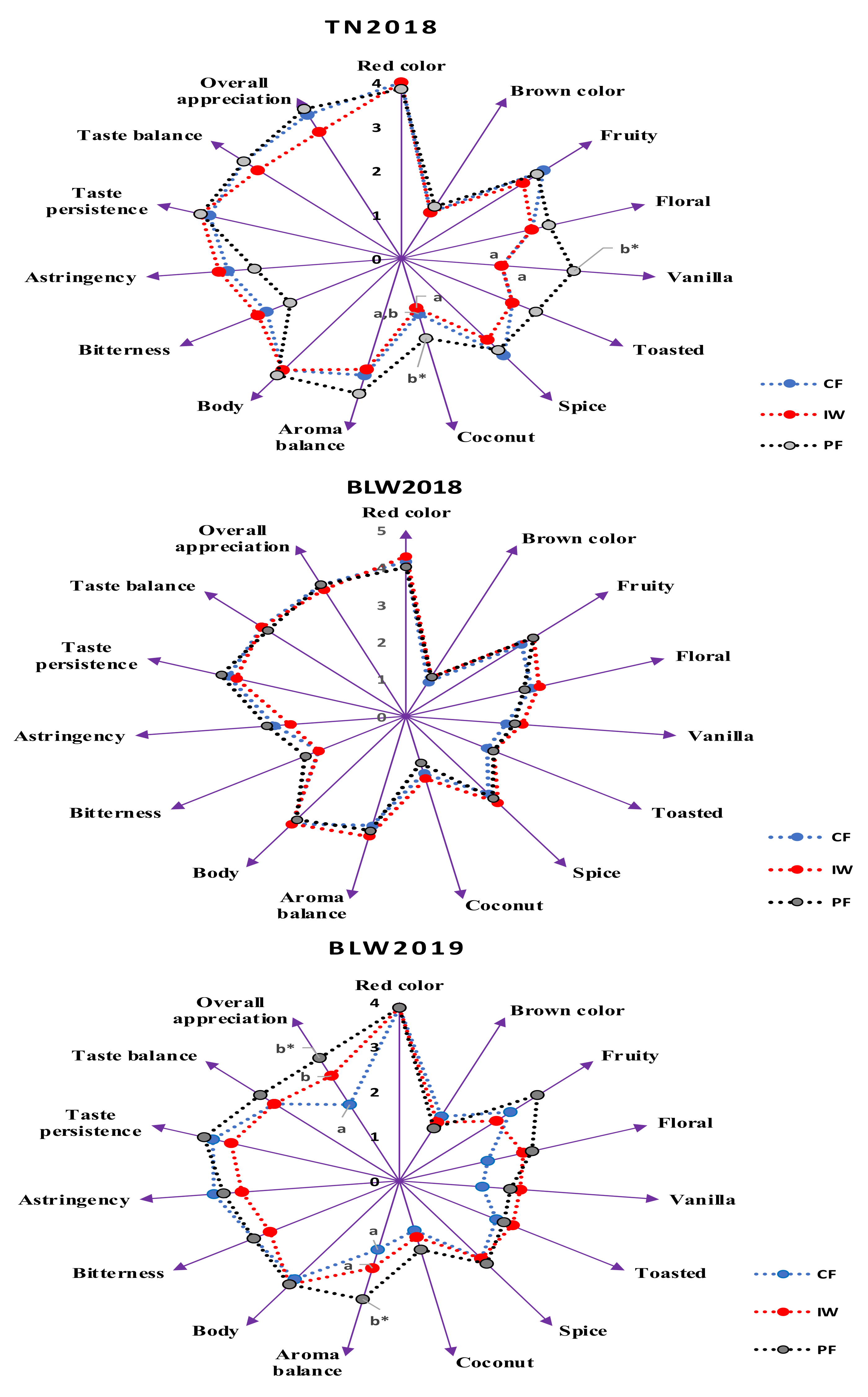
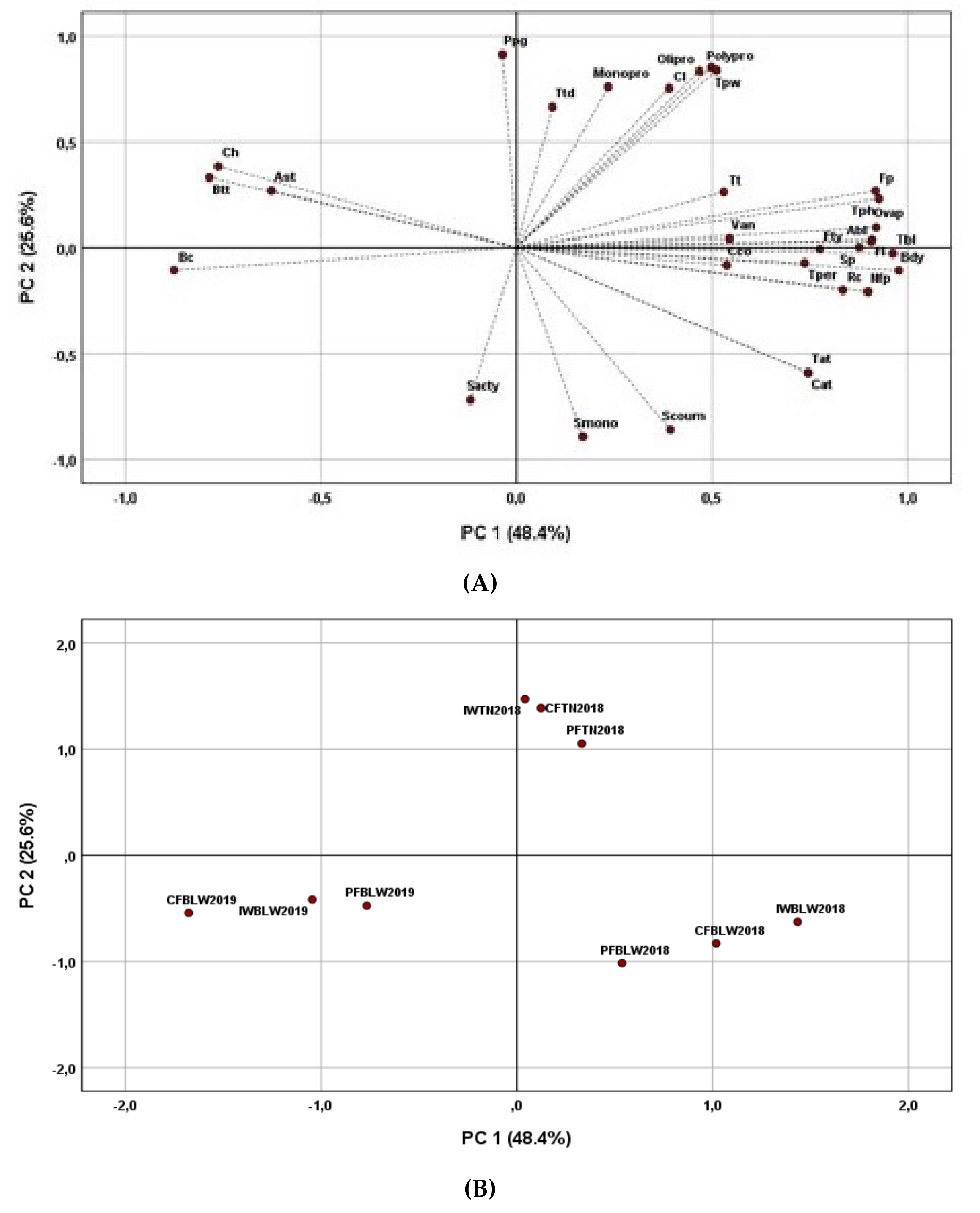
| Parameters | Red Wines | ||
|---|---|---|---|
| TN2018 | BLW2018 | BLW2019 | |
| Alcohol content (%, v/v) | 13.5 (0.09) | 13.6 (0.1) | 12.3 (0.1) |
| pH | 3.61 (0.001) | 3.64 (0.01) | 3.63 (0.01) |
| Total acidity (g/L, tartaric acid) | 5.40 (0.01) | 5.20 (0.01) | 5.40 (0.04) |
| Volatile acidity (g/L, acetic acid) | 0.24 (0.01) | 0.33 (0.01) | 0.38 (0.02) |
| Malic acid (g/L) | 0.10 (0.01) | 0.20 (0.01) | 0.20 (0.02) |
| Lactic acid (g/L) | 1.80 (0.04) | 1.70 (0.01) | 2.20 (0.03) |
| Free sulfur dioxide (mg/L) | 30 (0.9) | 30 (1.3) | 30 (0.9) |
| Reducing substances (1) (g/L) | 2.8 (0.09) | 3.0 (0.1) | 1.9 (0.09) |
| CIELab Coordinates | Red Wines | ||||||||
|---|---|---|---|---|---|---|---|---|---|
| TN2018 | BLW2018 | BLW2019 | |||||||
| IW | CF | PF | IW | CF | PF | IW | CF | PF | |
| L* | 60.24 a,* ± 0.02 | 61.06 c ± 0.03 (1.36%) (1) | 60.94 b ± 0.11 (1.16%) (1) | 65.39 b ± 0.03 | 63.06 a ± 0.04 (3.56%) (2) | 65.74 c ± 0.09 (0.53%) (1) | 69.29 a ± 0.32 | 69.44 a ± 0.01 (0.21%) (1) | 70.00 a ± 0.12 (1.02%) (1) |
| a* | 35.71 c ± 0.04 | 34.94 b ± 0.01 (2.15%) (2) | 34.37 a ± 0.08 (3.72%) (2) | 32.09 a ± 0.06 | 32.16 a ± 0.02 (0.21%) (1) | 32.04 a ± 0.04 (0.28%) (2) | 28.56 b ± 0.04 | 28.94 c ± 0.01 (1.33%) (1) | 27.91 a ± 0.03 (2.27%) (2) |
| b* | 2.64 a ± 0.01 | 3.06 b ± 0.03 (15.90%) (1) | 3.00 b ± 0.04 (13.63%) (1) | 3.25 a ± 0.03 | 3.51 b ± 0.03 (8.00%) (1) | 3.43 b ± 0.02 (5.53%) (1) | 4.24 a ± 0.14 | 4.17 a ± 0.02 (1.63%) (2) | 4.22 a ± 0.05 (0.47%) (2) |
| c* | 35.80 c ± 0.45 | 35.08 b ± 0.21 (2.01%) (2) | 34.50 a ± 0.11 (3.63%) (2) | 32.25 a ± 0.02 | 32.36 a ± 0.01 (0.34%) (1) | 32.22 a ± 0.03 (0.09%) (2) | 28.88 b ± 0.02 | 28.23 c ± 0.01 (2.25%) (1) | 28.22 a ± 0.01 (2.28%) (2) |
| ∆E | - | 1.20 a ± 0.01 | 1.58 a ± 0.03 | - | 2.35 a ± 0.03 | 1.56 a ± 0.01 | - | 0.46 b ± 0.02 | 1.13 a ± 0.03 |
| Monomeric Anthocyanin Group (mg/L) (1) | Red Wines | ||||||||
|---|---|---|---|---|---|---|---|---|---|
| TN2018 | BLW2018 | BLW2019 | |||||||
| IW | CF | PF | IW | CF | PF | IW | CF | PF | |
| ∑ Monoglucoside | 212.9 b,* ± 3.9 | 198.9 b ± 3.0 (6.5%) (2) | 157.6 a ± 7.9 (25.9%) | 322.0 b ± 5.0 | 306.6 a ± 2.9 (4.7%) | 305.7 a ± 6.7 (5.0%) | 289.1 b ± 7.2 | 263.2 a ± 3.1 (8.9%) | 267.0 a ± 7.9 (7.6%) |
| ∑ Acetylglucoside | 41.3 a ± 2.8 | 38.2 a ± 2.2 (7.5%) | 37.0 a ± 3.6 (10.4%) | 56.9 b ± 5.1 | 56.1 b ± 2.9 (1.4%) | 47.7 a ± 3.2 (16.1%) | 67.9 b ± 2.9 | 49.4 a ± 4.2 (27.2%) | 50.6 a ± 2.7 (25.4%) |
| ∑ Coumarylglucoside | 20.7 a ± 0.3 | 18.9 a ± 1.1 (8.6%) | 20.1 a ± 1.4 (2.89%) | 30.0 a ± 3.5 | 29.0 a ± 1.7 (3.3%) | 30.0 a ± 3.2 (0%) | 26.8 a ± 1.2 | 21.5 a ± 2.6 (19.7%) | 26.5 a ± 3.9 (1.1%) |
| Parameters | Red Wines | ||||||||
|---|---|---|---|---|---|---|---|---|---|
| TN2018 | BLW2018 | BLW2019 | |||||||
| IW | CF | PF | IW | CF | PF | IW | CF | PF | |
| Tanning power (NTU/mL) | 513.04 b,* ± 13.05 | 494.02 b ± 3.56 (3.71%) (1) | 460.87 a ± 4.56 (10.71%) | 422.79 c ± 19.33 | 369.27 b ± 0.97 (12.66%) | 307.75 a ± 9.43 (27.21%) | 319.79 b ± 6.34 | 271.33 a ± 9.19 (13.15%) | 307.83 b ± 9.56 (3.74%) |
| Fractions of Proanthocyanidins (mg/L) | IW | CF | PF | IW | CF | PF | IW | CF | PF |
| Monomeric | 18.78 b ± 0.50 | 16.95 b ± 0.46 (9.71%) (1) | 12.83 a ± 1.14 (31.65%) | 14.82 c ± 0.51 | 13.17 b ± 0.30 (11.09%) | 10.34 a ± 0.68 (30.21%) | 13.33 b ± 0.55 | 11.27 a ± 0.23 (15.41%) | 12.39 b ± 0.15 (7.03%) |
| Oligomeric | 99.64 c ± 1.08 | 93.80 b ± 1.73 (5.86%) | 85.55 a ± 1.25 (14.14%) | 83.05 b ± 2.65 | 79.25 b ± 0.67 (4.58%) | 72.65 a ± 1.22 (12.53%) | 73.43 c ± 0.90 | 66.29 a ± 0.53 (9.72%) | 68.70 b ± 0.47 (6.45%) |
| Polymeric | 862.87 c ± 4.70 | 839.29 b ± 1.27 (2.63%) | 815.83 a ± 5.14 (5.36%) | 721.17 c ± 2.48 | 709.58 b ± 2.76 (1.61%) | 695.08 a ± 3.68 (3.62%) | 646.30 c ± 2.96 | 594.33 a ± 3.61 (8.04%) | 614.67 b ± 4.03 (4.89%) |
Publisher’s Note: MDPI stays neutral with regard to jurisdictional claims in published maps and institutional affiliations. |
© 2022 by the authors. Licensee MDPI, Basel, Switzerland. This article is an open access article distributed under the terms and conditions of the Creative Commons Attribution (CC BY) license (https://creativecommons.org/licenses/by/4.0/).
Share and Cite
Rosária, M.; Oliveira, M.; Correia, A.C.; Jordão, A.M. Impact of Cross-Flow and Membrane Plate Filtrations under Winery-Scale Conditions on Phenolic Composition, Chromatic Characteristics and Sensory Profile of Different Red Wines. Processes 2022, 10, 284. https://doi.org/10.3390/pr10020284
Rosária M, Oliveira M, Correia AC, Jordão AM. Impact of Cross-Flow and Membrane Plate Filtrations under Winery-Scale Conditions on Phenolic Composition, Chromatic Characteristics and Sensory Profile of Different Red Wines. Processes. 2022; 10(2):284. https://doi.org/10.3390/pr10020284
Chicago/Turabian StyleRosária, Mariana, Miguel Oliveira, Ana C. Correia, and António M. Jordão. 2022. "Impact of Cross-Flow and Membrane Plate Filtrations under Winery-Scale Conditions on Phenolic Composition, Chromatic Characteristics and Sensory Profile of Different Red Wines" Processes 10, no. 2: 284. https://doi.org/10.3390/pr10020284






